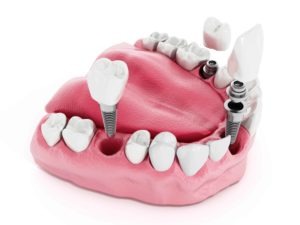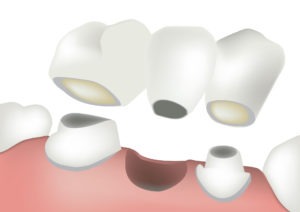
When considering followup treatment for an extraction, your dentist will often suggest a tooth bridge as the best option. This restoration replaces missing teeth. All dentistry has a cost and required treatment time. When comparing all treatment options, it is appropriate to ask, “how long does a tooth bridge last?”
One question our patients ask is, “How long will my tooth bridge last?” To help you better understand, we offer this overview.
How long will my tooth bridge last?
The answer to this question varies widely. Basically, a tooth bridge can last as few as five years or well over 20 years. Some patients maintain a useful bridge up to 30 years after it was placed. On average, a tooth bridge will last 10 to 15 years. It will have a variable service life determined by lifestyle and quality factors.
Factors that determine how long your traditional bridge will last include:
- Oral hygiene habits
- Bad oral habits such as chewing ice
- Number of visits to the dentist for check ups and cleanings
- Type of tooth bridge
- Quality of the tooth bridge (fit, how it was made, strength of materials)
- The material used to make the fixed bridge
- Overall general and oral health
- Eating habits, how much of your diet is carbohydrates and how many times you eat a day
- Jaw alignment issues
- Nighttime teeth grinding
One way to ensure that your tooth replacement lasts well over 10 years is to work with a quality dentist. A dentist that will support the optimal health of your teeth and gums and overall well being for the long term, through preventive care and state of the art treatment.
Tooth Bridge vs Dental Implant
 A tooth bridge is a row of false teeth
A tooth bridge is a row of false teeth
They are held in place over teeth on either side of the gap or through the use of advanced dental implants. If you are missing one or multiple teeth, a bridge can span the gap in your smile. Anyone who is missing most of their teeth will require a partial denture or multiple bridges or implants. A crown, bridge, or denture can be supported with implants.
One reason why a traditional tooth bridge may not last over 20 years is that the bridge is held in place by adjacent teeth. Before your tooth bridge can be placed, two teeth will need to be prepared. These teeth are called abutment teeth because they support the tooth bridge.
The prepping process requires the removal of the outer layer of your tooth. First, your tooth will be numbed using local anesthesia. Then, your dentist will gently remove part of the surface of your tooth.
You may be given a temporary bridge. When your final bridge is made, it will be placed on the abutment teeth to bridge the gaps in your smile. Those teeth now have to endure the pressure and wear of multiple teeth. Over time, this stress can weaken the supporting teeth.

The titanium implant acts as a tooth root
Tooth roots promote bone growth in our jaws. After the loss of a tooth, the bone near that tooth can partly go away. This can add to the sunken-in appearance of advanced aging.
To maintain a youthful smile, implants promote healthy jawbones and fill the gaps left after tooth loss. Implants also last a lifetime. With good oral hygiene habits to prevent gum disease and regular dental visits, the posts can remain in your jawbone indefinitely.
If you are looking for a long term solution to tooth or teeth loss, our doctor can tell you about the benefits of having your tooth bridge supported by implants.
This one reason why our doctor highly recommends considering implants. By using dental implants, you can avoid putting pressure on your natural teeth. The jawbone can easily support a crown or bridge, but nearby teeth may not be able to.
If you have concerns about how long your dental bridge will last, implants may be a better option for you. Implants are placed in the jawbone. Many of our patients who dislike their dentures slipping seek implants. Implants are the only restorative option that acts like natural teeth.
Other Considerations
You will have multiple materials to choose from, depending on your budget and dietary considerations. If you are looking for a very durable option, our office offers porcelain fused to metal. This option combines the strength of metal with the attractive qualities or porcelain.
Porcelain closely matches the color and shine of teeth. A bridge can be made completely out of porcelain. Having your bridge made of metal with a top layer of porcelain combines the benefits of both materials. Metal is more durable than porcelain.
The porcelain fused to metal bridge will be placed near the gum line so a dark line does now show. Many patients worry that the metal will show. This will not be the case, but this is also one reason why patients should prevent gum recession.
Other tips for maintaining your bridge include chewing evenly on both sides of your mouth and addressing nighttime teeth grinding. Porcelain will wear naturally. Eating on the side of the mouth with the bridge can wear the false teeth early. This can also put undue pressure on the supporting tooth roots.
Bruxism can easily damage your tooth bridge. If your teeth show signs of wear, your dentist can have you fitted with a protective mouthguard. Never try to pull off or reattach your tooth bridge. If your bridge does come loose, someone at our office will work to quickly schedule an appointment.
Schedule Your Tooth Bridge Consultation Today
A quality bridge can improve your quality of life. Research has shown that the loss of one tooth can increase your chances of experiencing another tooth loss. By placing a dental bridge, you can prevent further tooth loss. Tooth loss can lead to teeth drifting, jaw alignment problems and headaches.
Eliminate the gap created by tooth loss or advanced tooth decay. We offer a wide range of bridge options, including a cantilever bridge and Maryland bridge. To stay ahead of those preventable dental problems, please contact our office today by calling (847) 234-0517.

 A tooth bridge is a row of false teeth
A tooth bridge is a row of false teeth